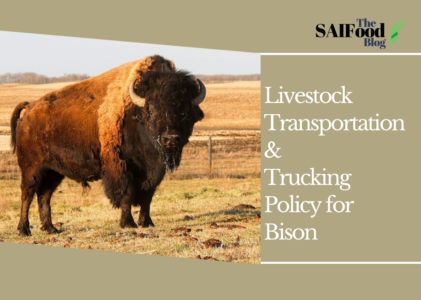By Deanna Kitzul, University of Saskatchewan
The Canadian Livestock Transportation regulations date back to 1977 before the amendment made by The Canadian Food Inspection Agency in 2019. The amended regulations for livestock transportation occurred in 2019 and were implemented for 2020. The amendments demonstrate stronger regulations to improve the health and wellbeing of animals during the complete transportation process. The objective is to increase consumer confidence, strengthen Canada’s international trade status, and facilitate market access (CFIA, 2019). The amendment includes shorter transportation hours, training requirements, and having contingency plans a necessity for everyone involved in the transport to better align with international standards. Though these improvements are great for animals’ wellbeing, the new 36 hours for ruminants raise concern for Canadian Bison ranchers, such as my family, and our fellow industry members.

To explain my reasoning, my family’s ranch exports all of our bison to slaughter firms in North Dakota and Colorado, as this is where we receive the best return for our bison. Abiding to the trucking policy daily requirements of not exceeding 13-hours of driving, and 10-hours off-duty in a day, one truck driver can accomplish our bison shipments (Government of Canada, 2020). Travel time to North Dakota from Bankend, SK is approximately a seven-and-a-half-hour truck time for the bison, 690km, which isn’t a concern for prairie bison ranchers. A concern for prairie bison producers is that from Bankend, SK to Brush, Colorado, 1440km, truck time for the bison is just shy of 36 hours. Brush Meat Processors in Colorado is a primary slaughter firm for bison producers in the prairie provinces. The updated livestock transportation and trucking policies have created challenges in exporting bison for a select number of producers, specifically in Northern Alberta (Kremeniuk, 2020).
A census in 2016 reported 119,314 bison on 975 Canadian farms and ranches, with an estimate of 156,000 bison on the 975 ranchers as of January 1st, 2020 (CBA, 2020). The bison industry is a niche market within Canada, and a key component is that there are only four slaughter facilities in Canada that are federally inspected and can ship bison within North America: two in Alberta, one in Manitoba, and one in Quebec. Of the four, only two are certified to ship product to Europe. In recent years due to the exchange rate, and the available non-competitive bison markets within Canada, compared to American bison markets, only one-third of the bison produced in Canada are slaughtered in Canada with two-thirds slaughtered in the United States (Kremeniuk, 2020). The prices that Canadian bison producers receive from American slaughter firms are much greater than what we would receive from Canadian firms due to the currency exchange and demand. It is for this reason that the Canadian Livestock Transportation Policy and Canadian Trucking Policy should have exceptions for the transportation of bison.
Exceptions for ranchers that reside outside of the legal transportation time frame to primary slaughter firms in the United States could make a substantial difference to bison producers in Canada. Specifically, an exception to ranchers that have used American slaughter firms before the amendment, and that reside within a 40-hour truck time, given there is a new safe policy in place for truck drivers transporting bison. An exception towards the truck policy could be a 15-hour driving, 10-hour off-duty, and a 15-hour driving period that fit into a 70-hours in 7 days, and a 120-hours in 14-day cycle (Government of Canada, 2020). The extension of four hours of driving and on-truck time may be enough to allow prairie ranchers and truck drivers to legally and safely transport bison.
A solution of having two truck drivers for one load does solve the problem for some producers if two truck drivers are available. But if not, profitable resources become limited for bison producers that reside outside of the legal transportation time-frame. In my opinion, especially if markets continue to be more profitable for Canadian bison producers in the United States, a four-hour extension of on-truck for livestock, should be extended for producers that qualify. For the trucking policy, without extending their maximum of 70 hours in seven-days and 120 hours in a 14-day cycle, the exception of one period of 15-hour driving, 10-hour off-duty, and 15-hour driving hours could be acceptable for the transportation of bison. This can ensure that the well-being of bison, truckers, and producers’ livelihoods are safe.
Below are a few photos of our bison!
[su_image_carousel source=”media: 13974,13975,13978,14015″ limit=”27″ slides_style=”minimal” align=”center” captions=”yes” autoplay=”1″ image_size=”medium”]
[su_accordion][su_spoiler title=”References” open=”no” style=”default” icon=”plus” anchor=”” class=””][su_list icon=”icon: check” icon_color=”#47907C”]
- Government of Canada. (2020). Daily driving and on-duty time. Retrieved from https://laws-lois.justice.gc.ca/eng/regulations/SOR-2005-313/page-2.html#h-719527 on September 20th, 2020.
- Government of Canada. (2019). Government of Canada announces changes to humane transport requirments under the Health of Animals Regulations. Retrieved from https://www.canada.ca/en/food-inspection-agency/news/2019/02/government-of-canada-announces-changes-to-humane-transport-requirements-under-the-health-of-animals-regulations.html on September 20th, 2020.
- Kremeniuk, T. (2020). Personal Interview with Executive Director of The Canadian Bison Association, email, May 10th, 2020.
- Kremeniuk, T. (2020). Personal Interview with Executive Director of The Canadian Bison Association, email, September 26th, 2020.
- Len Dubois Trucking Inc. (2020). Basic HOS in Canada. Retrieved from http://lenduboistrucking.com/blog/trucking-hours-of-service-basics/#:~:text=You’re%20limited%20to%2013,includes%20Off%2DDuty%20and%20Sleeper, on September 22nd, 2020.
[/su_list] [/su_spoiler][/su_accordion]

Deanna Kitzul
Howdy! I am Deanna Kitzul and I was raised on a grain and bison ranch near Foam Lake, SK. This is my fourth year of an Agribusiness degree and Field Crop Production minor in the College of Agriculture and Bioresources at the University of Saskatchewan. I chose the College of Ag because I truly have a passion for agriculture and bison. My future aspirations of once I complete my degree are still unknown as I have three courses to finish up in the fall of 2021, but I am returning to Cargill this summer for a Global Edible Oil Solutions position. Once I complete my degree, I have a few company’s in mind that I would love to work for and learn from in their 1-year internship positions. I truly want to be able to have the knowledge and resources to help farmers and ranchers, and this college and my summer work positions have been a great influence on my career.


